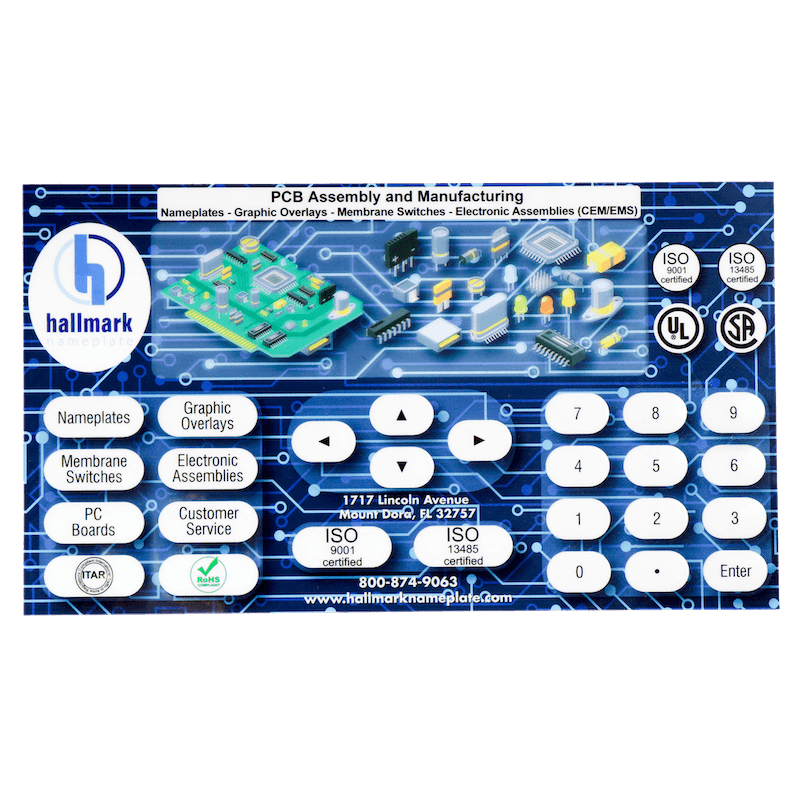Membrane Switch: A Comprehensive Guide to Its Uses and Applications
Membrane Switch: A Comprehensive Guide to Its Uses and Applications
Blog Article
Recognizing Membrane Switches Over: The Key to Sturdy and Trusted Controls

What Are Membrane Layer Switches?
Membrane buttons are an innovative remedy in the realm of user interface innovation, combining capability and design seamlessly. These devices function as an interface between individuals and digital systems, incorporating numerous elements right into a small style. Generally built from versatile, thin layers of materials, membrane buttons are developed to react to touch, enabling users to communicate with machinery and electronic devices effectively.
The primary components of a membrane layer switch include a printed circuit layer, graphic overlay, and a spacer layer that avoids unintentional activation. The graphic overlay can be tailored to mirror brand name identity or user choices, improving aesthetics while making certain use. Membrane layer switches are frequently used in various applications, including clinical gadgets, customer electronic devices, and industrial equipment, owing to their resilience and resistance to ecological aspects such as wetness and dust.
Among the key advantages of membrane layer switches is their capability to withstand damage, making them perfect for high-traffic settings. In addition, they are lightweight and call for minimal room, enabling innovative layouts in item growth. Overall, membrane layer switches over represent a efficient and functional selection for modern-day digital interfaces, weding technology with user-centric layout principles.
Exactly How Membrane Switches Over Job
The procedure of membrane layer switches over joints on a straightforward yet effective device that converts customer input into electronic signals. When a user presses the switch, the leading layer warps, enabling a conductive element in the circuit layer to make contact with an equivalent conductive pad on the underside of the visuals overlay.
The layout of membrane layer buttons can vary, but they often incorporate domes or tactile elements to provide responses to the individual, improving the general experience - membrane switch. The materials used in membrane layer switches, such as polyester or polycarbonate, add to their sturdiness and resistance to environmental aspects, including moisture and dust. The published circuits are normally enveloped, which protects them from wear and tear over time.
Advantages of Membrane Switches

In addition, membrane buttons are recognized for their durability. Constructed from robust materials, they are immune to dirt, dampness, and physical wear, which significantly prolongs their lifespan contrasted to standard mechanical buttons. This resilience makes them particularly ideal for high-traffic environments and applications calling for durability.
An additional significant benefit is the simplicity of cleaning and upkeep. The smooth surface of membrane layer switches lessens dust buildup and is frequently impervious to spills, making them perfect for settings that call for constant sanitization.
In addition, membrane layer buttons offer a structured profile, leading to a thinner design that can be incorporated into various devices without including mass. This attribute not just boosts the visual allure but likewise contributes to a much more ergonomic product design.
Applications of Membrane Buttons
Versatile and easy to use, membrane buttons find applications across a large range of markets, including clinical devices, customer electronic devices, and commercial devices. In the clinical area, these switches are essential to gadgets such as analysis tools, individual monitoring systems, and infusion pumps, where integrity and simplicity of cleaning are essential. Their capacity to hold up against rough settings and preserve functionality makes them perfect for such applications.

In customer electronic devices, membrane buttons are made use of in products like microwaves, cleaning machines, and push-button controls - membrane switch. Their smooth design enables for instinctive interface, improving the general individual experience while giving sturdiness and resistance to wear and tear
Industrial tools additionally gains from membrane buttons, particularly in control panels for equipment and automation systems. These buttons supply protection versus dirt and moisture, making certain constant efficiency in challenging atmospheres. Their personalized attributes enable producers to tailor them to specific functional demands, improving efficiency and functionality.
Selecting the Right Membrane Layer Switch
When choosing a membrane layer button, it is important to consider different factors that affect performance and viability for particular applications. The key considerations consist of environmental conditions, tactile responses, longevity, and layout specs.
First, assess the operating atmosphere; buttons exposed to moisture, chemicals, or severe temperature levels require certain materials to guarantee durability and functionality. Next, evaluate the requirement for responsive comments. Depending on user communication, some applications might benefit from a responsive reaction to verify activation, while others might favor a non-tactile style for visual reasons.
Durability is one more essential element; membrane layer buttons should be designed to endure regular use, effects, and abrasion. Guarantee the selected switch explanation can endure the expected lifecycle, particularly in high-usage circumstances.

Conclusion
Finally, membrane switches over function as essential elements in the layout of trustworthy and durable control systems across various industries. Their compact design, integrated with robust building and construction and adjustable features, boosts customer interaction while guaranteeing long life in requiring environments. The versatility of membrane layer switches enables customized options that meet details functional demands, reinforcing their relevance in modern technology. As markets proceed to evolve, the significance of incorporating efficient membrane button options can not be overstated.
Membrane switches over stand for an important aspect of modern user interface design, blending performance with durability in various applications.Membrane layer switches are an advanced option in the world of user interface technology, incorporating functionality and design perfectly. Usually built from versatile, read here slim layers of products, membrane buttons are designed to react to touch, allowing customers to communicate with equipment and electronic devices efficiently.
The style of membrane switches can differ, however they commonly include domes or tactile components to offer feedback to the individual, improving the overall experience.In verdict, membrane layer changes offer as necessary components in the design of read here long lasting and dependable control systems across different industries.
Report this page